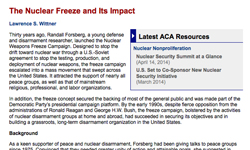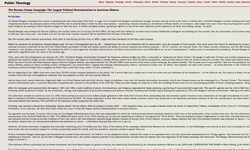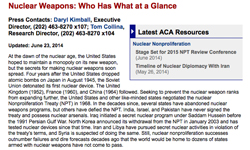Home >> Films >> WORLD PEACE is a Local Issue >> Information and Resources
The Nuclear Freeze Movement
In 1945, the first nuclear weapons test was performed, and, by 1954, the first group opposing nuclear testing was formed in Japan. In the decades that followed, an international movement sprung up, with groups and protests forming in countries all over the world.
ARTICLES

The Nuclear Freeze Movement and People-to-People Diplomacy: 1980-1990
(2002)
The success of the "nuclear freeze" idea, initiated in 1980 by a young disarmament researcher, Randall Forsberg, caught many by surprise.
More...

The Nuclear Freeze and
Its Impact
(December 2010)
Thirty years ago, Randall Forsberg, a young defense and disarmament researcher, launched the Nuclear Weapons Freeze Campaign.
More...

What Activists Can Learn from the Nuclear Freeze Movement
(August 18, 2013)
Two decades ago, Ronald Reagan had been elected President, and the hawks were riding high.
More...

The History of the Campaign for Nuclear Disarmament
(2010)
In the 1950s Europe was gripped by a very real fear of nuclear conflict and, building on the work of earlier anti-war movements, CND was launched with a massive public meeting
More...

The Nuclear Freeze Campaign: The Largest Political Demonstration in
American History
(February 9, 2011)
By the beginning of the 1980s there were more than 50,000 nuclear weapons deployed on
the planet.
More...

Lawrence Wittner's take on the future of the nuclear disarmament movement
(June 9, 2010)
The last 19 months have been a tumultuous time for the nuclear disarmament movement, placing it, today, on the cusp of some important decisions
More...
CURRENT STATUS
An overview of best estimates of the current status, globally, of nuclear weapons which still exist, which could be activated for use

World Nuclear Stockpile Report
(Updated January 7, 2014)
The exact number of nuclear weapons in global arsenals is not known. With little exception, each of the nine countries with nuclear weapons guards these numbers as closely held national secrets. What is known, however, is that more than a decade and...
More...

The Center for Arms Control and Non-Proliferation Fact Sheet: Global Nuclear Weapons Inventories in 2014
(April 30, 2014)
Nuclear weapons programs are generally shrouded in secrecy and all of the totals should be considered estimates. The numbers are based on the most...
More...

Nuclear Weapons: Who Has What at a Glance
(Updated June 23, 2014)
An estimate by the Arms Control Association of the number and owners of existing nuclear weapons.
More...

TIMELINE
In preparation for the Nuclear Security Summit that took place in March 2014 in the Hague (the Netherlands), the HCSS Nuclear Timeline was created to provide a comprehensive overview of key events in nuclear history. It traces the long legacy of nuclear security threats and policies and puts these developments in a broader context. Events covered span a wide range of fields, including scientific developments, nuclear power, (non-)proliferation efforts and safety and security issues.
August, 1942
The Manhattan Project is established
July 16, 1945
Trinity/First Detonation of Nuclear Device (White Sands, NM)
August 6, 1945
United States Bombs Hiroshima
August 9, 1945
United States Bombs Nagasaki
July 1-25, 1946
Bikini Atoll Tests
March 1, 1954
Castle Bravo Test (Bikini Atoll) Contaminates Rongelap and Utirik Atolls and Japanese Fishing Boat, Lucky Dragon No. 5
1955
Gensuikyo (Japanese Council Against Atomic and Hydrogen Bombs) Is Formed
July 9, 1955
Russell-Einstein Manifesto issued in London
1957
Campaign for Nuclear Disarmament Formed (England)
The Committee for a SANE Nuclear Policy Formed (USA)
First Pugwash Conference Held (Pugwash, Nova Scotia)
January 14, 1958
Linus Pauling Presents Petition to United Nations
April 4-7, 1958
First Aldermaston March (England)
October 31, 1958
Geneva Test Ban (USA, Britain and USSR)
January, 1961
President Kennedy takes office
November 1, 1961
Women Strike for Peace March (USA)
November 24, 1961
Resolution 1653 - Declaration on the Prohibition of the Use of Nuclear and Thermo-Nuclear Weapons (UN)
October 1962
Cuban Missile Crisis
October 10, 1963
Limited Test Ban Treaty (USA, Britain and USSR) Linus Pauling Wins Nobel Peace Prize
November 22, 1963
JFK Assassination/President Johnson Takes Office
April 22, 1968
Treaty of Tlatelolco Takes Effect
January 1969
President Nixon Takes Office
March 5, 1970
Treaty on the Non-Proliferation of Nuclear Weapon Takes Effect
(USA, Britain, USSR)
May 26, 1972
Anti-Ballistic Missile Treaty/SALT I (USA and USSR)
July 1974
Threshold Test Ban Treaty (USA and USSR)
January 20, 1977
President Jimmy Carter Takes Office
May 17, 1978
UN General Assembly Session on Nuclear Disarmament (Paul Newman delegate)
June 18, 1979
SALT II (USA and USSR)
November 1980
Randall Forsberg.s Nuclear Freeze Ballot Initiative Passes (Western MA)
November 18, 1980
President Reagan Proposes Zero Option
1981
Randy Kehler's Nuclear Weapons Freeze Campaign Launches
January 20, 1981
Ronald Reagan Becomes President (USA)
March 1981
First National Conference of the Freeze Movement (Center for Peace Studies, Georgetown University)
March 3, 1981
62% of Vermont Town Meetings Voted to Back Nuclear Weapons Freeze
June 3, 1981
William Thomas/White House Peace Vigil
March 10, 1982
Senate Joint Resolution 163, Nuclear Freeze Amendment, Introduced to US Senate by Kennedy and Hatfield
June 12, 1982
One Million Person "Freeze the Arms Race" Fund Human Needs. Anti-Nuclear Demonstration (Central Park, NYC)
Fall 1982
Nuclear Freeze Referenda Appeared on Ballot in 10 states, the District of Columbia, and 37 Cities and Counties Across US
1983
Palo Alto City Council Meeting
March 8, 1983
"Nuclear Freeze Lobby Day" Organized by Citizens' Lobby for a U.S Soviet Nuclear Weapons Freeze (U.S. Capitol Building)
March 23, 1983
President Reagan Gives "Star Wars" Speech
May 4, 1983
U.S. House of Representatives Passes Freeze Resolution 278-149, Introduced by Ed Markey
Summer 1983
Seneca Women's Encampment for a Future of Peace and Justice
(Seneca County, NY)
June 20, 1983
International Day of Nuclear Disarmament protests (USA)
November 20, 1983
"The Day After" Airs on ABC
July 10, 1985
Greenpeace Ship Rainbow Warrior Destroyed On Way to Protest French Nuclear Tests
August 6, 1985
The South Pacific Nuclear Free Zone Treaty Signed (Rarotonga, Cook Islands)
December 10, 1985
The International Physicians for the Prevention of Nuclear War Receives the Nobel Peace Prize
March 1, 1986
Great Peace March for Global Nuclear Disarmament Launches (USA)
April 26, 1986
Chernobyl Disaster (Ukraine)
August 31, 1986
CTBT Opened for Signature
December 8, 1987
Intermediate-Range Nuclear Forces Treaty (USA and USSR)
January 20, 1989
President George H. W. Bush Takes Office
July 31, 1991
Strategic Arms Reduction Treaty I (USA and USSR)
December 26, 1991
Soviet Union Formally Dissolves
1993
START II (US and USSR)
January 20, 1993
President Bill Clinton Takes Office
March 1993
South Africa Becomes First Country to Relinquish Working Nuclear Weapons
October 13, 1995
The Pugwash Conferences Receives Nobel Peace Prize
August 31, 1996
CTBT Opened for Signature
March 27, 1997
The Treaty of Bangkok Goes Into Effect
November 1997
President Clinton Issues New Guidelines on U.S. Nuclear Weapons Doctrine
January 20, 2001
President George W. Bush Takes Office
June 1, 2003
Strategic Offensive Reductions Treaty (USA and Russia)
September 19, 2005
Last US MX Missile Decommissioned
October 24, 2008
United Nations Secretary-General Ban Ki-moon addresses the East-West Institute: "A world free of nuclear weapons would be a global public good of the highest order."
March 21, 2009
Central Asian Nuclear-Weapon-Free Zone Treaty Goes Into Effect
July 15, 2009
The Treaty of Pelindaba Goes Into Effect
April 2010
Tehran International Conference on Disarmament and Non-Proliferation
February 5, 2011
New START Treaty (USA and Russia)
March 11, 2011
Fukushima Daiichi Nuclear Disaster (Japan)
May 24, 2011
20,000 Protest (Switzerland)
May 25, 2012
Senate Armed Services Committee authorizes more than $3 billion in WMD nonproliferation spending for the coming fiscal year as well as $7.6 billion to manage the U.S. nuclear arsenal









